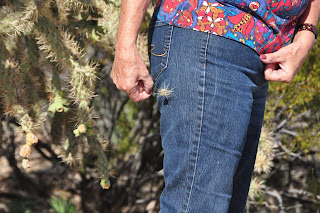Monday Feb 6 This morning bright and early we took the RV in to Carl's RV Service for the required work on the bedroom slide. We had hoped our new Good Sam's insurance would cover it. We did some running around getting some necessary things done and got a call to come back by Carl's.
Instead of the rollers being the problem, they found that we had moisture penetration in the left rear of the coach around the slide out, and that this had caused the wood in the floor to deteriorate, thus causing the bottom of the slide to drop down when being extended or retracted, and that was the reason that it was difficult to open and close. After extensive conversation with Good Sam's, we found that water penetration was NOT covered under our policy, thus we're going to pay for it. It seems that there is always a way that insurance companies can find a way NOT to pay. So, we took it on the chin and Carl's said it would take a couple of days. So it's off to a hotel.
 |
| Do I jump now - or later? |
 |
| What can we do now? The "new" view from our bedroom. |
Tuesday, February 7 we decide to make the best of a bad situation and enjoy the day. We head to the Titan Museum about 20 miles South of town.
This was an especially interesting tour for me. In the late 60's and early 70's, I was a pilot on the B-52 and had spent many weeks on alert with our plane loaded with nuclear weapons that would or could be delivered to Russia in case of a war. It is hard to believe today that in those decades, the US and Russia could have ended life as we know it on earth through the use of these awful weapons. It was a policy referred to as Mutually Assured Destruction (MAD). If Russia attacked the US using nuclear weapons, we had the capability, through missles like the Titan, B-52's, and nuclear submarines around the world, the respond by attacking Russia. And with nuclear weapons of the type and number each country had, we could pretty well assured that the world as we know it would be changed, if not completely lifeless.
This seems hard to believe today, but that was the world as we knew it then.
Going through this museum, which is the only surviving Titan missle launch site remaining, brought back many memories of those days when I sat on alert with the potential that I would be a contributer to MAD.
 |
| The business end of the Titan Missle. This one missle carried as much destructive power as all bombs dropped in WWII plus the two nuclear weapons dropped on Japan that ended WWII. |
 |
| Going below ground to the control rooms where the missle crews lived and had the capability to launch a nuclear missle. |
 |
| The control room from which a missle could be launched, located far below ground and designed to withstand a direct nuclear hit. |
On the way back to Tucson, we stopped by a Copper Mining Museum. The mining here is open pit mining like at Aurora and there are huge flat mountains of tailing.
 |
| This is one big truck |
 |
| Glad I don't have to buy these tires |
We went back by Carl's and they were finishing up the work on the RV, so tonight we are back "home". It sure is better than a hotel.
Carl's did an excellent job of making the repair. It's much better than it came from the factory. Hopefully, we won't have that kind of problem anymore.




































